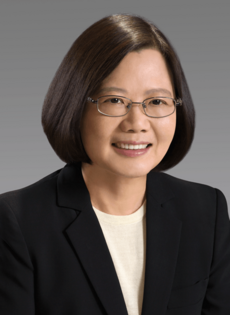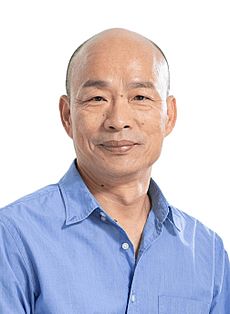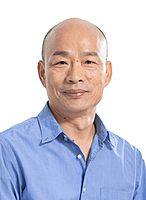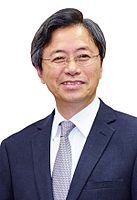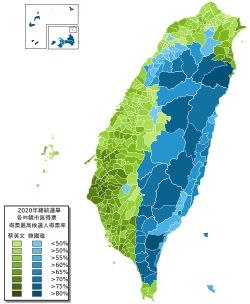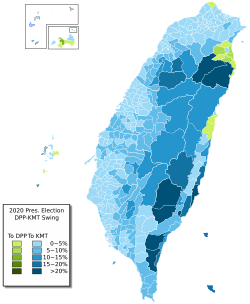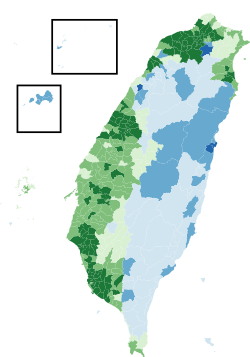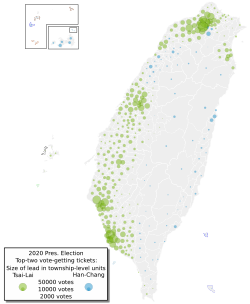2020 Taiwanese presidential election facts for kids
Quick facts for kids |
||||||||||||||||||||
|
||||||||||||||||||||
| Registered | 19,311,105 | |||||||||||||||||||
|---|---|---|---|---|---|---|---|---|---|---|---|---|---|---|---|---|---|---|---|---|
| Turnout | 74.90% ( |
|||||||||||||||||||
|
||||||||||||||||||||

Results by county-level unit
|
||||||||||||||||||||
|
||||||||||||||||||||
On January 11, 2020, people in Taiwan voted for their next president. They also voted for members of the Legislative Yuan, which is like their parliament.
The winner was the current president, Tsai Ing-wen, from the Democratic Progressive Party (DPP). Her running mate, who would become Vice President, was Lai Ching-te. They won against Kaohsiung mayor Han Kuo-yu from the Kuomintang (KMT). Another candidate was James Soong.
Before this election, Tsai Ing-wen's party had lost many local elections in 2018. She even stepped down as her party's leader for a while. Both the DPP and KMT had tough internal contests to pick their candidates.
Two main topics were important during the election campaign. One was about problems inside Taiwan, like jobs and the economy. The other was about Taiwan's relationship with mainland China. Tsai Ing-wen was very strong in her views against China's pressure on Taiwan. This was especially true after the big protests in Hong Kong. Many people felt her strong stance helped her win.
A lot of people voted in this election, about 74.9%. This was the highest number since 2008. Tsai Ing-wen received over 8.17 million votes. This was about 57.1% of all votes. It was the most votes ever for a DPP presidential candidate. Tsai and Lai started their new terms on May 20, 2020.
Contents
Who Can Run for President?
In Taiwan, the president and vice president are chosen together. People vote directly for them. This means the person with the most votes wins. This 2020 election was the seventh time people directly voted for their president. Before 1996, the president was chosen by a different group called the National Assembly.
To run for president, a political party needed to have received more than five percent of the votes in the last election. The main parties that could join were the Democratic Progressive Party (DPP), Kuomintang (KMT), New Power Party (NPP), and People First Party (PFP). In the end, three main candidates ran:
- President Tsai Ing-wen from the Democratic Progressive Party.
- Kaohsiung mayor Han Kuo-yu from the Kuomintang.
- Veteran politician James Soong from the People First Party.
The current Vice President, Chen Chien-jen, could have run again with Tsai, but he decided not to.
Important Issues in the Election
Tsai Ing-wen faced some challenges before the election. Her party lost many local elections in 2018. People were unhappy about things like pension reforms and environmental issues. There were also some problems involving her staff.
A very important event that changed the election was the protests in Hong Kong. These protests started because people in Hong Kong were worried about losing their freedom. Tsai Ing-wen used this to show that Taiwan needed to protect its own freedom from mainland China.
In January 2019, China's leader, Xi Jinping, suggested a "one country, two systems" plan for Taiwan. This plan would mean Taiwan would become part of China but keep some freedom. However, several small countries also stopped being friends with Taiwan and became friends with China instead. Tsai Ing-wen strongly said that Taiwan would "never accept one country, two systems." She warned that "today's Hong Kong could be tomorrow's Taiwan." Her strong message helped her gain a lot of support.
Tsai Ing-wen then chose Lai Ching-te as her running mate. This helped unite her party. The Kuomintang chose Han Kuo-yu as their candidate. Han had become very popular after winning the mayoral election in Kaohsiung in 2018. However, some people criticized him for running for president so soon after becoming mayor.
Han Kuo-yu was also seen as being too friendly with mainland China. He had visited China and supported the "1992 Consensus", which Tsai Ing-wen did not agree with. Even though Han later said he would not accept "one country, two systems" if he were president, Tsai had already gained a political advantage on this issue.
During the election, both sides accused each other of using fake accounts online to spread rumors.
How Candidates Were Chosen
Democratic Progressive Party (DPP)
After losing many local elections in 2018, President Tsai Ing-wen's chances for re-election seemed low. She even resigned as the party leader. Polls showed that many Taiwanese people preferred Lai Ching-te for president.
However, Tsai's popularity grew after she gave a strong speech. She said that Taiwan would never give up its democratic freedoms. This was a response to China's leader, Xi Jinping, who had said Taiwan's unification with China was "inevitable."
On March 18, 2019, Lai Ching-te announced he would run against Tsai in the party's primary election. This was the first time a sitting president faced such a strong challenge from within their own party.
Tsai Ing-wen won the primary and was officially chosen by the DPP on June 19, 2019. She and Lai Ching-te then became the DPP's presidential team on November 17, 2019.
DPP Nominees
| 2020 Democratic Progressive ticket | |||||||||||||||||||||||||||
| Tsai Ing-wen | Lai Ching-te | ||||||||||||||||||||||||||
|---|---|---|---|---|---|---|---|---|---|---|---|---|---|---|---|---|---|---|---|---|---|---|---|---|---|---|---|
| for President | for Vice President | ||||||||||||||||||||||||||
| President of the Republic of China (2016–present) |
Premier of the Republic of China (2017–2019) |
||||||||||||||||||||||||||
Kuomintang (KMT)
Eric Chu, a former KMT chairman, was the first major politician to announce he would run for president. Other candidates also joined the race.
The KMT decided to choose its candidate based mostly on public opinion polls. Han Kuo-yu, the mayor of Kaohsiung, was very popular in these polls. Terry Gou, the founder of Foxconn, also announced he would join the KMT primary.
Han Kuo-yu won the KMT's primary election on July 15, 2019. On November 11, Chang San-cheng joined Han's ticket as the vice presidential candidate. They officially registered for the election on November 18, 2019.
KMT Nominees
| 2020 Kuomintang ticket | |||||||||||||||||||||||||||
| Han Kuo-yu | Chang San-cheng | ||||||||||||||||||||||||||
|---|---|---|---|---|---|---|---|---|---|---|---|---|---|---|---|---|---|---|---|---|---|---|---|---|---|---|---|
| for President | for Vice President | ||||||||||||||||||||||||||
| Mayor of Kaohsiung (2018–2020) |
Premier of the Republic of China (2016) |
||||||||||||||||||||||||||
People First Party (PFP)
On November 13, 2019, James Soong, the leader of the People First Party, announced he would run for president for the fourth time. His running mate was Sandra Yu.
PFP Nominees
| 2020 People First ticket | |||||||||||||||||||||||||||
| James Soong | Sandra Yu | ||||||||||||||||||||||||||
|---|---|---|---|---|---|---|---|---|---|---|---|---|---|---|---|---|---|---|---|---|---|---|---|---|---|---|---|
| for President | for Vice President | ||||||||||||||||||||||||||
 |
|||||||||||||||||||||||||||
| Governor of Taiwan (1994–1998) |
United Communications Group chairwoman (2009–2018) |
||||||||||||||||||||||||||
Candidate Debates
The candidates had one television debate on December 29, 2019. They talked about many topics, but the relationship with mainland China was a main focus. They also discussed military spending, energy, and jobs.
Tsai Ing-wen said she wanted to keep things as they were with China, without causing problems. Han Kuo-yu said he would protect Taiwan's independence. James Soong said Taiwan shares Chinese culture but any changes to its status must be democratic.
During the debate, Han Kuo-yu often criticized Tsai Ing-wen. He said she was not good at managing the economy or dealing with problems. Tsai said Han did not have clear plans and only attacked her. She reminded people of the Hong Kong protests and warned, "do not let Taiwan be the next Hong Kong." Both candidates accused each other of using online trolls.
Han Kuo-yu's behavior during the debate was sometimes unusual. He raised his voice and used hand gestures. He also asked the other candidates if they believed in God.
Election Results
| Candidate | Running mate | Party | Votes | % | |
|---|---|---|---|---|---|
| Tsai Ing-wen | Lai Ching-te | Democratic Progressive Party | 8,170,231 | 57.13 | |
| Han Kuo-yu | Chang San-cheng | Kuomintang | 5,522,119 | 38.61 | |
| James Soong | Sandra Yu | People First Party | 608,590 | 4.26 | |
| Total | 14,300,940 | 100.00 | |||
| Valid votes | 14,300,940 | 98.87 | |||
| Invalid/blank votes | 163,631 | 1.13 | |||
| Total votes | 14,464,571 | 100.00 | |||
| Registered voters/turnout | 19,311,105 | 74.90 | |||
| Source: CEC | |||||
President Tsai Ing-wen won the 2020 Taiwanese presidential election. She was re-elected for a second term. She received a record 8.17 million votes, which was 57.1% of all votes. This was the highest vote share ever for a DPP candidate in a presidential election.
Her main opponent, Han Kuo-yu from the Kuomintang (KMT), came in second. He received 5.52 million votes, or 38.6%. Even though he lost, the KMT did better than in the 2016 election. They gained more votes in areas that usually support the KMT.
James Soong from the People First Party came in third. He received about 600,000 votes, which was 4.26%. The total number of people who voted was 74.9%. This was the highest turnout for a national election since 2008.
After the results were announced, President Tsai said that democratic Taiwan would not give in to threats. She said the election results made that very clear.
| Subdivision | Tsai Ing-wen | Han Kuo-yu | James Soong
Sandra Yu |
Invalid | Total | Electorate | Turnout | |||
|---|---|---|---|---|---|---|---|---|---|---|
| Votes | % | Votes | % | Votes | % | |||||
| Total | 8,170,231 | 57.13 | 5,522,119 | 38.61 | 608,590 | 4.26 | 163,631 | 14,464,571 | 19,311,105 | 74.90% |
| New Taipei City | 1,393,936 | 56.52 | 959,631 | 38.91 | 112,620 | 4.57 | 28,041 | 2,494,228 | 3,321,459 | 75.09% |
| Taipei City | 875,854 | 53.65 | 685,830 | 42.01 | 70,769 | 4.34 | 21,381 | 1,653,834 | 2,167,264 | 76.31% |
| Taoyuan City | 718,260 | 54.78 | 529,749 | 40.40 | 63,132 | 4.82 | 14,066 | 1,325,207 | 1,780,755 | 74.42% |
| Taichung City | 967,304 | 56.95 | 646,366 | 38.06 | 84,800 | 4.99 | 20,550 | 1,719,020 | 2,251,064 | 76.36% |
| Tainan City | 786,426 | 67.38 | 339,702 | 29.10 | 41,075 | 3.52 | 12,341 | 1,179,589 | 1,556,845 | 75.77% |
| Kaohsiung City | 1,097,621 | 62.23 | 610,896 | 34.63 | 55,309 | 3.14 | 17,006 | 1,780,832 | 2,299,558 | 77.44% |
| Yilan County | 173,657 | 63.28 | 90,010 | 32.80 | 10,739 | 3.91 | 3,029 | 277,435 | 375,608 | 73.86% |
| Hsinchu County | 152,380 | 46.88 | 154,224 | 47.45 | 18,435 | 5.67 | 3,970 | 329,009 | 438,049 | 75.11% |
| Miaoli County | 147,034 | 45.02 | 164,345 | 50.32 | 15,222 | 4.66 | 3,578 | 330,179 | 447,422 | 73.80% |
| Changhua County | 436,336 | 57.17 | 291,835 | 38.24 | 35,060 | 4.59 | 10,277 | 773,508 | 1,035,507 | 74.70% |
| Nantou County | 152,046 | 50.83 | 133,791 | 44.72 | 13,315 | 4.45 | 3,555 | 302,707 | 413,485 | 73.21% |
| Yunlin County | 246,116 | 61.56 | 138,341 | 34.60 | 15,331 | 3.83 | 5,203 | 404,991 | 565,269 | 71.65% |
| Chiayi County | 197,342 | 64.22 | 98,810 | 32.16 | 11,138 | 3.62 | 3,748 | 311,038 | 428,640 | 72.56% |
| Pingtung County | 317,676 | 62.16 | 179,353 | 35.10 | 14,021 | 2.74 | 4,992 | 516,042 | 688,793 | 74.92% |
| Taitung County | 44,092 | 38.12 | 67,413 | 58.28 | 4,163 | 3.60 | 1,119 | 116,787 | 179,536 | 65.05% |
| Hualien County | 66,509 | 35.91 | 111,834 | 60.38 | 6,869 | 3.71 | 2,081 | 187,293 | 269,558 | 69.48% |
| Penghu County | 27,410 | 53.85 | 20,911 | 41.08 | 2,583 | 5.07 | 644 | 51,548 | 88,432 | 58.29% |
| Keelung City | 114,966 | 50.82 | 99,360 | 43.92 | 11,878 | 5.25 | 2,458 | 228,662 | 311,801 | 73.34% |
| Hsinchu City | 144,274 | 55.26 | 102,725 | 39.34 | 14,103 | 5.40 | 3,423 | 264,525 | 345,345 | 76.60% |
| Chiayi City | 99,265 | 61.37 | 56,269 | 34.79 | 6,204 | 3.84 | 1,664 | 163,402 | 215,055 | 75.98% |
| Kinmen County | 10,456 | 21.77 | 35,948 | 74.83 | 1,636 | 3.41 | 423 | 48,463 | 120,721 | 40.14% |
| Lienchiang County | 1,226 | 19.81 | 4,776 | 77.16 | 188 | 3.04 | 82 | 6,272 | 10,939 | 57.34% |
Maps Showing Results
Reactions from Other Countries
- Australia: The Australian government congratulated Tsai Ing-wen on her re-election.
See also
 In Spanish: Elecciones presidenciales de la República de China de 2020 para niños
In Spanish: Elecciones presidenciales de la República de China de 2020 para niños


